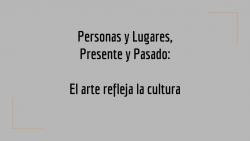Kris Murphy's collections
People, Place and Time: How Art Reflects Culture - Collection 3 - Caja De Memoria Viva II: Constancia Colón de Clemente by Adrián Román (
<p>In this collection, designed for a Spanish-speaking classroom, students will explore how art reflects culture when analyzing “<em>Caja De Memoria Viva II: Constancia Colón de Clemente</em>” by Adrian “Viajero” Román. In this three-dimensional multimedia<em> installation, the artist</em> portrays a black Puerto Rican woman who migrated to the United States in the 1940s. This portrait allows the artist (in his own words) “ to embark on a quest to visually represent how precious our memories are and capture the dignity in the people’s struggle and validate their existence.” The collection includes a <a href="https://docs.google.com/document/d/1YLlgqQEvOWuRBsXVCI3ev04vbq4y4xHciKTM0rpA_Z0/edit">teacher's guide in English</a> and suggested authentic resources both in Spanish and English to be adapted by teachers of multiple disciplines.<br /></p>
<p> Students will observe and analyze this three dimensional work of art and they will describe both its exterior and interior. Students will create their own box to reflect their heritage and personal story or that of a Hispanic figure.<br /></p>
<p>This collection is one of three that explore<strong> “People, Place, and Time: How Art Reflects Culture.” </strong>Products, practices and perspectives displayed in Latinx art, show how our place and history (past) influence who we are (present) and who we want to be (future) in geographical, social, economic, and/or historical contexts. In the three collections, Latin American works of art illustrate how culture shapes the way we see the world, others, and ourselves, and they also raise awareness about Latinx diversity.</p>
<p>The three collections were created by Marcela Velikovsky (Bullis School) and Vicky Masson (Christ Episcopal School) as part of the <strong>2018 Smithsonian Virtual Teacher Curricula Creation Opportunity</strong> with the Smithsonian Center for Learning and Digital Access (SCLDA), and thanks to the Smithsonian Latino Center's Latino Initiative Pool Funds. The three collections highlight Latino history, art and culture,and use Harvard Project Zero Thinking Routines and Global Thinking Routines strategies. </p>
<p>The Smithsonian Learning Lab collections provide an opportunity to invigorate the World Language (Foreign Language) curriculum as it allows to effectively integrate online museum resources (authentic resources) towards a 21st century curriculum. They facilitate student-centered activities within a variety of themes such as, family and communities, personal and public identities, social values and customs, holidays and celebrations, immigration, ethnic groups, Hispanic Heritage, image and stereotypes, inequality and discrimination, global issues, religious practices, etc. They also provide the opportunity to analyze art, read portraiture, and investigate art media.</p>
<p>These collections also consider ACTFL standards (Communication, Connections, Comparisons, Communities and Culture), Asia Society Global Competence skills, the Sustainable Development Goals (Global Goals), Teaching Tolerance Social Justice standards, the Framework for Developing Global and Cultural Competencies to Advance Equity, Excellence and Economic competitiveness, and Participate Global Competencies.</p>
<p><span></span></p>
<p># National Portrait Gallery #The Outwin # Adrián “Viajero” Román # Caja de Memoria Viva II # Spanish # Puerto Rico # New York # Empathy # Inequality # Critical thinking # Curiosity # Heritage # Stories #LatinoHAC</p>
<p><br /></p>
 Kris Murphy
Kris Murphy
45


